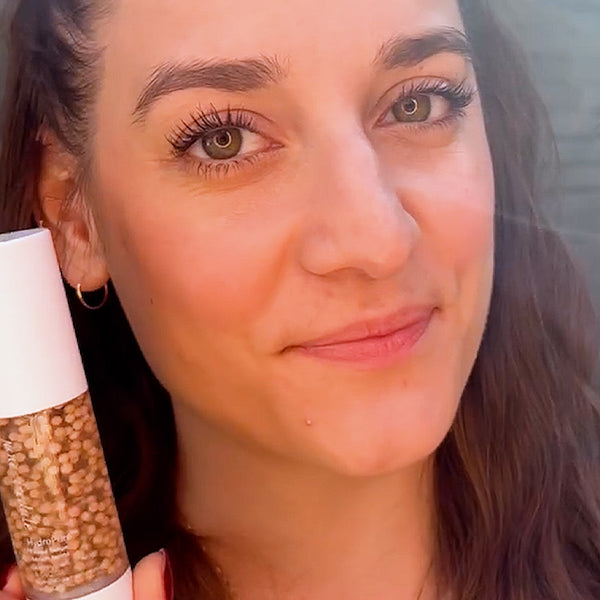
If you’ve ever been confused about bronzers—what they’re supposed to do, how you’re supposed to choose one, and where the heck you’re supposed to apply them—well, of course you have. Bronzers are weirdly confusing. And it doesn’t help that in the past decade or so that they’ve risen in popularity alongside contouring products, which are vaguely similar to bronzers, but also very different! Then there’s the matter of finding the right shade, and also the right formula… Well today, makeup artist Harold James is here to help. The Paris-based bronzer wizard walked ITG through the ins and outs of adding warmth to any complexion.
First, figure out what you want overall
People get tripped up over bronzers for a lot of reasons, but confusion over whether or not you’re supposed to contour with a bronzer is probably number one. So let’s set this for the record once and for all: bronzers are purely meant to add warmth to your skin, and they are not contouring products! The big difference is that contouring formulas, with their cooler tones, are meant to obscure parts of the face. As a result, they sculpt definition. “Contour mimics the shadows of your face,” explains Harold. “You can’t use a bronzer to create shadow because most bronzers have too much warmth.” Bronzers enhance the parts of your face where light hits almost in the same way a highlighter does, but instead of adding luminosity, it adds a layer of rich, sun-kissed heat.
Then, pick up the right shade
Harold says that “finding your shade is very personal” because you first have to decide how “warm” you’d like to look. Going for a subtle sun-kissed glow? A bronzer one to two shades darker than your foundation is good for an everyday level of warmth. If you’re angling to fake a day at the beach, try two to three shades darker. But you’re going to have to experiment no matter what, because this really isn’t a hard and fast rule. And please, please try to ignore viral bronzer tutorials that come across your screen. “Social media is a different world because you need a much darker bronzer to translate through the camera,” explains Harold. “When it’s too dark in real life, it can look very harsh.”
And…the right formula
You’ll want to avoid traditional cream formulas if you’re a bronzer newbie, since those tend to be more pigmented and allow less room for user error. Instead, go for liquid or gel-creams because they are “easy to blend,” says Harold. It’s OK to stick with a powder bronzer if you’re super oily…but the most important thing to consider for either of these formulas is to start small and build up as needed. Harold says “When you do that, it’s nearly impossible to mess up.”
Apply bronzer using this technique…
OK, so you have your bronzer in-hand. Now, it’s time to apply it. Harold says he prefers to paint pigment on with his fingers. “When you warm up the texture in your hands, it’s even easier to blend it out.” Like Harold said before, start with a very small amount, and then see how that blends into your overall look. After that first pass, Harold likes to deepen the coverage with a Beautyblender. “If you want even more control and coverage, you can use a dense brush instead.” Make sure you don’t go overboard. “There’s such a misconception that you should apply a lot of bronzer, but that looks awful,” says Harold. “In the beginning it’s really satisfying, but in the end it will dry down patchy.”
…And this roadmap
Where the sun hits your face is your ultimate bronzer roadmap. Start with the forehead—Harold likes to dot the hairline with pigment. Then he moves down the face, where he dots pigment right on top of the cheekbones. Overall, you want bronzer to be “very blended and hidden,” explains Harold. “Sometimes I like to add bronzer on top of the nose for extra warmth, and also down on the chest. That especially gives this sensual and seamless look.”
But wait! Let’s talk about makeup order of operations for a moment
Harold says it best: “If you want the bronzer to be soft, you apply it before foundation. We call that underpainting. Let it dry, and then you apply the foundation. The result is a very diffused, sun-kissed look. If you want more control and want it to be more precise, do it after the foundation, but before the blush. It gives more dimension to the face. This is very good when you have to take pictures.”
Now try it the Parisian way
“In France they love terracotta—that’s what they call bronzers,” says Harold. “You have to have it, otherwise you look sad.” Women will wear nothing but bronzer and lipstick, but, he adds, “this is very serious.” When it comes to Parisians and bronzers, “it can’t be too orange.”
Or not! Up to you
The best thing about bronzers is their versatility. There are only so many places you can wear blush, for example. But bronzers? Sky’s the limit. “The ultimate goal is to bring warmth,” Harold reiterates. That could really be anywhere on your face. Even as a base on your lids. “It brings such beautiful depth there.”
Photos via ITG






